国际经济学2 的习题
- 格式:ppt
- 大小:299.00 KB
- 文档页数:41
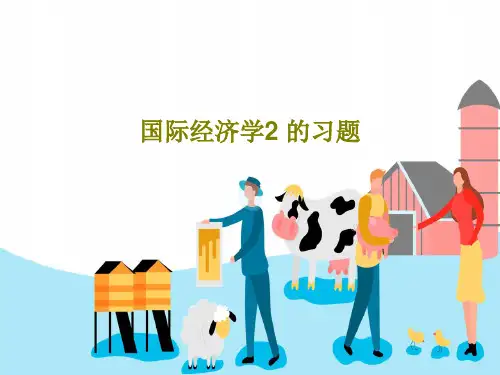
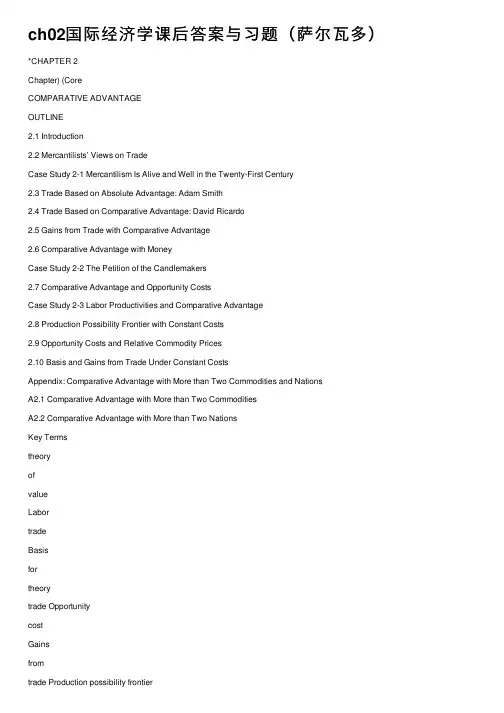
ch02国际经济学课后答案与习题(萨尔⽡多)*CHAPTER 2Chapter) (CoreCOMPARATIVE ADVANTAGEOUTLINE2.1 Introduction2.2 Mercantilists’ Views on TradeCase Study 2-1 Mercantilism Is Alive and Well in the Twenty-First Century2.3 Trade Based on Absolute Advantage: Adam Smith2.4 Trade Based on Comparative Advantage: David Ricardo2.5 Gains from Trade with Comparative Advantage2.6 Comparative Advantage with MoneyCase Study 2-2 The Petition of the Candlemakers2.7 Comparative Advantage and Opportunity CostsCase Study 2-3 Labor Productivities and Comparative Advantage2.8 Production Possibility Frontier with Constant Costs2.9 Opportunity Costs and Relative Commodity Prices2.10 Basis and Gains from Trade Under Constant CostsAppendix: Comparative Advantage with More than Two Commodities and NationsA2.1 Comparative Advantage with More than Two CommoditiesA2.2 Comparative Advantage with More than Two NationsKey TermstheoryofvalueLabortradeBasisfortheorytrade OpportunitycostGainsfromtrade Production possibility frontierofPatterncostopportunityConstantMercantilismcommodityRelativeprices advantageAbsolutespecializationCompleteLaissez-faireLaw of comparative advantage Small-country case-7-Lecture Guide1. This is a long and crucial core chapter and may require four classes to cover adequately. In thefirst lecture, I would present Sections 1-4 and assign review questions 1-3.2. In the second lecture of Chapter 2, I would concentrate on Sections 5-6 and carefully explain the law of comparative advantage using simple numerical examples, as in the text. Both sections are crucial. Section 5 explains the law of comparative advantage and Section 6 establishes the link between trade theory and international finance. I find that the numerical explanations before the graphical analysis really helps the student to truly understand the law. The simple lawyer-secretary example should also render the law more immediately relevant to the student. I would also assign Problems 4-7.3. In the third lecture, I would cover Sections 7-9 and assign Problems 8-10.4. In the fourth lecture, I would Section 10 and go over problems 4-10. The appendixes could bemade optional for the more enterprising students in the class.Answer to Review Questions and Problems1. The mercantilists believed that the way for a nation to become rich and powerful was toexport more than it imported. The resulting export surplus would then be settled by an inflow of gold and silver and the more gold and silver a nation had, the richer and more powerful it was. Thus, the government had to do all in its power to stimulate the nation’s exports and discourage and restrict imports. However, since all nations could not simultaneously have an export surplus and the amount of gold and silver was fixed at any particular point in time, one nation could gain only at the expense of other nations. The mercantilists thus preached economic nationalism, believing that national interests were basically in conflict.Adam Smith, on the other hand, believed that free trade would make all nations better off.All of this is relevant today because many of the arguments made in favor of restrictinginternational trade to protect domestic jobs are very similar to the mercantilists argumentsmade three or four centuries ago. That is why we can say that “mercantilism is alive and well in the twenty-first century”. Thus we have to be prepared to answer and demonstrate thatthese arguments are basically wrong.2. According to Adam Smith, the basis for trade was absolute advantage, or one country being more productive or efficient in the production of some commodities and other countriesbeing more productive in the production of other commodities.The gains from trade arise as each country specialized in the production of the commodities in which it had an absolute advantage and importing those commodities in which the nation had an absolute disadvantage.Adam Smith believed in free trade and laissez-faire, or as little government interference with the economic system as possible. There were to be only a few exceptions to this policy of laissez-faire and free trade. One of these was the protection of industries important for national defense.3. Ricardo’s law of comparative advantage is superior to Smith’s theory of absolute advantage inthat it showed that even if a nation is less efficient than or has an absolute disadvantage in theproduction of all commodities with respect to the other nations, there is still a basis for beneficial trade for all nations.The gains from trade arise from the increased production of all commodities that arises wheneach country specializes in the production of and exports the commodities of its comparativeadvantage and imports the other commodities.A nation that is less efficient than others will be able to export the commodities of its compara-tive advantage by having its wages and other costs sufficiently lower than in other nations so asto make the commodities of its comparative advantage cheaper in terms of the same currencywith respect to the other nations.4. a. In case A, the United States has an absolute and a comparative advantage in wheat and theUnited Kingdom in cloth.In case B, the United States has an absolute advantage (so that the United Kingdom has anabsolute disadvantage) in both commodities.In case C, the United States has an absolute advantage in wheat but has neither an absoluteadvantage nor disadvantage in cloth.In case D, the United States has an absolute advantage over the United Kingdom in bothcommodities.b. In case A, the United States has a comparative advantage in wheat and the United Kingdomin cloth.In case B, the United States has a comparative advantage in wheat and the United Kingdomin cloth.In case C, the United States has a comparative advantage in wheat and the United Kingdomin cloth.In case D, the United States and the United Kingdom have a comparative advantage in neither commodities.5. a. The United States gains 1C.b. The United Kingdom gains 4C.c. 3C < 4W < 8C.d. The United States would gain 3C while the United Kingdom would gain 2C.6. a. The cost in terms of labor content of producing wheat is 1/4 in the United States and 1 in the United Kingdom, while the cost in terms of labor content of producing cloth is 1/3 in theUnited States and 1/2 in the United Kingdom.b. In the United States, Pw=$1.50 and Pc=$2.00.c. In the United Kingdom, Pw=£1.00 and Pc=£0.50.7. The United States has a comparative disadvantage in the production of textiles. Restrictingtextile imports would keep U.S. workers from eventually moving into industries in which the United States has a comparative advantage and in which wages are higher.8. Ricardo’s explanation of the law of comparative is unacceptable because it is based on the labor theory of value, which is not an acceptable theory of value.The explanation of the law of comparative advantage can be based on the opportunity costdoctrine, which is an acceptable theory of value.9. The production possibilities frontier reflects the opportunity costs of producing bothcommodities in the nation.The production possibilities frontier under constant costs is a (negatively sloped) straight line. The absolute slope of the production possibilities frontier reflects or gives the price of thecommodity plotted along the horizontal axis in relation to the commodity plotted along thevertical axis.10. a. See Figure 1.b. In the United States Pw/Pc=3/4, while in the United Kingdom, Pw/Pc=2.c. In the United States Pc/Pw=4/3, while in the United Kingdom Pc/Pw=1/2.d. See Figure 2.The autarky points are A and A' in the United States and the United Kingdom, respectively. The points of production with trade are B and B' in the United States and the UnitedKingdom, respectively.The points of consumption are E and E' in the United States and the United Kingdom,respectively. The gains from trade are shown by E > A for the U.S. and E' > A' for the U.K.Fig 1.1aU.K. Fig 1.1bFigure1Fig 1.2aFig 1.2bFigure2Multiple-Choice Questions1. The Mercantilists did not advocated:*a. free tradeb. stimulating the nation's exportsc. restricting the nations' importsd. the accumulation of gold by the nation2. According to Adam Smith, international trade was based on:*a. absolute advantageb. comparative advantagec. both absolute and comparative advantaged. neither absolute nor comparative advantage3. What proportion of international trade is based on absolute advantage?a. allb. most*c. somed. none4. The commodity in which the nation has the smallest absolute disadvantage is the commodityof its:a. absolute disadvantageb. absolute advantagec. comparative disadvantaged. comparative advantage5. If in a two-nation (A and B), two-commodity (X and Y) world, it is established that nationA has a comparative advantage in commodity X, then nationB must have:a. an absolute advantage in commodity Yb. an absolute disadvantage in commodity Yc. a comparative disadvantage in commodity Y*d. a comparative advantage in commodity Y6. If with one hour of labor time nation A can produce either 3X or 3Y while nation B canproduce either 1X or 3Y (and labor is the only input):a. nation A has a comparative disadvantage in commodity Xb. nation B has a comparative disadvantage in commodity Y*c. nation A has a comparative advantage in commodity Xd. nation A has a comparative advantage in neither commodity7. With reference to the statement in Question 6:a. Px/Py=1 in nation Ab. Px/Py=3 in nation Bc. Py/Px=1/3 in nation B*d. all of the above8. With reference to the statement in Question 6, if 3X is exchanged for 3Y:a. nation A gains 2X*b. nation B gains 6Yc. nation A gains 3Yd. nation B gains 3Y9. With reference to the statement of Question 6, the range of mutually beneficial trade between nation A and B is:a. 3Y < 3X < 5Yb. 5Y < 3X < 9Y*c. 3Y < 3X < 9Yd. 1Y < 3X < 3Y10. If domestically 3X=3Y in nation A, while 1X=1Y domestically in nation B:a. there will be no trade between the two nationsb. the relative price of X is the same in both nationsc. the relative price of Y is the same in both nations*d. all of the above11. Ricardo explained the law of comparative advantage on the basis of:*a. the labor theory of valueb. the opportunity cost theoryc. the law of diminishing returnsd. all of the above12. The Ricardian trade model has been empirically*a. verifiedb. rejectedc. not testedd. tested but the results were inconclusive13. The Ricardian model was tested empirically in terms of differences ina. relative labor productivities costs in various industries among nationsb. relative labor costs in various industries among nations*c. relative labor productivities and costs in various industries among nationsd. none of the above14. A difference in relative commodity prices between two nations can be based upon a difference in:a. factor endowmentsb. technologyc. tastes*d. all of the above15. In the trade between a small and a large nation:a. the large nation is likely to receive all of the gains from trade*b. the small nation is likely to receive all of the gains from tradec. the gains from trade are likely to be equally sharedd. we cannot say。
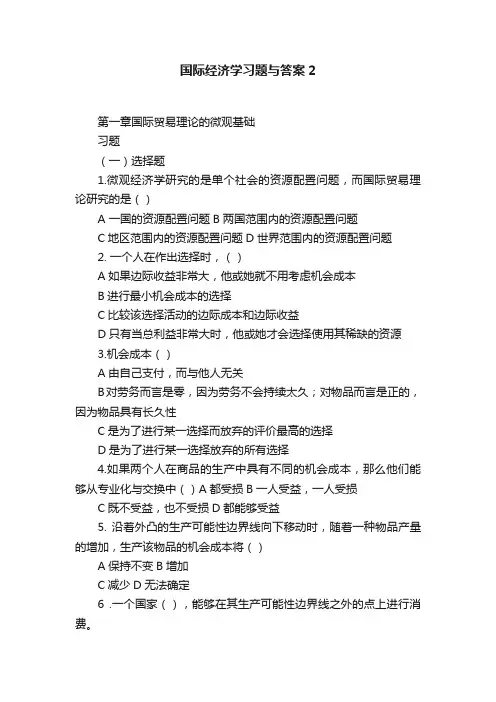
国际经济学习题与答案2第一章国际贸易理论的微观基础习题(一)选择题1.微观经济学研究的是单个社会的资源配置问题,而国际贸易理论研究的是()A 一国的资源配置问题B两国范围内的资源配置问题C地区范围内的资源配置问题D世界范围内的资源配置问题2. 一个人在作出选择时,()A如果边际收益非常大,他或她就不用考虑机会成本B进行最小机会成本的选择C比较该选择活动的边际成本和边际收益D只有当总利益非常大时,他或她才会选择使用其稀缺的资源3.机会成本()A由自己支付,而与他人无关B对劳务而言是零,因为劳务不会持续太久;对物品而言是正的,因为物品具有长久性C是为了进行某一选择而放弃的评价最高的选择D是为了进行某一选择放弃的所有选择4.如果两个人在商品的生产中具有不同的机会成本,那么他们能够从专业化与交换中()A都受损B一人受益,一人受损C既不受益,也不受损D都能够受益5. 沿着外凸的生产可能性边界线向下移动时,随着一种物品产量的增加,生产该物品的机会成本将()A保持不变B增加C减少D无法确定6 .一个国家(),能够在其生产可能性边界线之外的点上进行消费。
A没有任何时候B在充分就业的情况下C同其他国家进行贸易时D所有生产要素全部投入生产的时候7.供给曲线除了表示不同的价格水平所提供的商品数量外,还可以被认为是()A愿意并有能力支付的曲线B边际收益曲线C供给的最高价格曲线D供给的最低价格曲线8. 在封闭条件下,一国生产技术的改进降低了棉花的生产成本,那么棉花的价格(),棉花的生产数量()A上升;增加B上升;减少C下降;增加D下降;减少9 .对于两国贸易模型来说,国际均衡价格一定处于两国贸易前的()A最低相对价格水平之下B最高相对价格水平之上C相对价格水平之间D根据具体情况而定10 .经济学家作出这样的假设:作为一种目标,消费者总是在追求()A其效用最大化B其收入的最大化C其边际效用的最大化D以上选项均不对(二)简答题1如何理解狭义和广义的国际贸易,国际贸易理论的主要研究对象是什么?2既然国际贸易理论与微观经济学的基本原理存在着一致性,为什么还要区分国际贸易与国内贸易,将国际贸易作为一个独立的问题来研究呢?3用相对价格概念解释经济行为主体是如何摆脱“货币幻觉”的影响的。
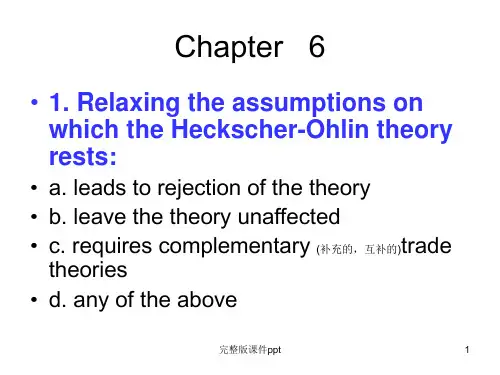


international(国际经济学)课后习题及答案----------------------- Page 1-----------------------Review Questions and Condensed Answers forInternational Trade TheoriesChapter 1 World Trade and the National EconomyReview Questions::::1( What features distinguish international from domestic transactions?2( What can you say about the growth of world trade in both nominal and real terms? Was itfaster than the growth of output?3( Evaluate the statement,” the United States is a closed economy, hence foreign trade is ofno consequence to it.”4( Distinguish between export industries, import-competing industries and nontraded goods.Give examples of each.5( Using the figure in table 1-3, what can you say about the trade structure of the USA andJapan.Condensed Answers to Review Questions::::1. The text discusses ways that international transactions differfrom domestic ones.i. International trade requires that transactions be conductedbetween twocurrencies mediated by an exchange rate. Domestic transactions are conductedin a single currency.ii. Commercial policies that operate to restrict international transactions cannot, ingeneral, be imposed on domestic trade. Such policies include tariffs, quotas,voluntary export restraints, export subsidies, and exchange controls.iii. Countries pursue different domestic macroeconomic policieswhich result indivergent rates of economic growth, inflation, and unemployment.iv. More statistical data exist on the nature, volume, and value of internationaltransactions than exist in domestic trade.v. Factors of production are more mobile domestically than internationally.vi. Countries exhibit different demand patterns, sales techniques,and marketingrequirements. Many of these are due to culture and custom. Someresult fromdifferences in government regulations. Included here are health, safety,environmental, and technical rules.2. The real volume of world exports grew at an annual rate of more than 6 percent between1950 and 2000. Global output grew at an annual rate of 4 percent. Export growth inexcess of output growth reflects the increased openness to trade of many countries.3. The United States is a relatively closed economy since the share of trade in GDP issmaller than that of most other industrial nations. In 2000, U.S. exports of goods andservices were 11 percent of GDP. The U.S. economy is less dependent on the foreignsector than other major economies, but to say that foreign trade is of no consequence is anexaggeration. The U.S. economy has become increasingly open and, therefore, moreimpacted by trade developments over time. This trend is likely to continue. Curtailingimports would, for example, have a big effect on consumers' ability to buy some goods----------------------- Page 2-----------------------(e.g. tropical products) and would raise the prices of others. The absence of certain keycommodities and material inputs would greatly disrupt areas of U.S. industry.4. a. Export industries send a substantial share of their output abroad. Ratios ofexports to GDP are much higher than the average ratio for all industries. Netexporting industries are those for which exports exceed imports. U.S. netexporting industries include farm products, chemicals, certain types of machinery,and aerospace products.b. Import-competing industries are domestic industries that sharethe domesticmarket with a substantial import presence. These activities haveratios ofimports to GDP that are much higher than the average ratio for all industries.U.S. import-competing industries include fuels, automobiles,clothing, footwear,and iron and steel.c. Nontraded goods are those which, because of their nature and characteristics, arenot easily exported or imported. Examples are hair-dressing, movie theaters,meals, construction activity, and health-care.5. Table 1.3 contains figures on the trade structure of the U.S. and Japan. The U.S. is a netexporter of food, certain ores, chemicals, and other machinery and transport equipment,and is a net importer of raw materials, mining products, fuels, nonferrous metals, iron andsteel, semimanufactures, office and telecommunications equipment, automotive products,textiles and clothing, and other consumer goods. Japan is a net exporter of iron and steel,chemicals, semimanufactures, office and telecommunications equipment, automotiveproducts, other machinery and transport equipment, and other consumer goods. Importsexceed exports in food, raw materials, and textiles and clothing.----------------------- Page 3-----------------------Chapter 2 Why Nations TradeReview Questions::::1( a. In what sense are the cost data of footnote 4 related to the figures of scheme 1?b. Based on the figures of footnote 4, determine the:Direction of trade once it develops.Limits to mutually beneficial trade.Limits to a sustainable exchange trade.2. Evaluate the following statements:a. In international trade, domestic cost ratios determine the limits of mutually beneficial trade,whereas demand considerations show where, within these limits, the actual exchange ratio will lie.b. Comparative advantage is a theoretical concept. It cannot be used to explain any real-worldphenomena.c. The opening up of trade raises the price of export goods; hence trade is inflationary.d. The concept of absolute advantage offers explainations for East Germany’s high unemploymentrates in the 1990s.3. a. Use the theory of comparative advantage to explain why it pays for:The USA to export grains and import oil.Russia to export oil and import grains.b. Why does the popular press believe that grain exports are inflnationary? What is wrongwith this porposition?Condensed Answers to Review Questions:1. a. Scheme 1 is based on labor productivity comparisons, while Footnote 4presentsper unit cost data. Production cost ratios are inversely related to productivitymeasures.b. i. Textiles will be exported from the U.K. and wheat from the U.S.ii. The U.S. will trade only if one yard of textiles costs less than3 bushels ofwheat. The U.K. will trade only if 1 yard of textiles can be exchangedfor more than 2 bushels of wheat.iii. The value of the ? must be between $1 and $1.502. a. Consider Figure 2.2. The domestic cost ratios define limits of mutually beneficialtrade. Within the region of mutually beneficial trade the actual exchange rate willbe determined by the relative intensity of each country's demand for the othercountry's product. A full analysis requires an understanding of reciprocal demandcurves, but the following general principle might help heuristically. If the Britishare more eager to buy U.S. wheat than the Americans are eager for British textiles,the exchange ratio falls close to the U.K. domestic cost ratio and the U.S. can beviewed as capturing a greater share of the gains from trade.b. Since the real world does not conform to the convenienttwo-country, two-goodassumptions, the simple theoretical model is not immediately applicable.However, we can generalize the model to many goods and many nations. Thefundamental truth remains. Countries export those goods in which their relativeproduction costs are lower and import those goods for which the relative costs arehigher.----------------------- Page 4-----------------------c. While trade tends to raise the prices of exportables in the domestic economy, theeffect of trade is to lower the average price level of all goods. Trade givesconsumers an opportunity to consume at lower world prices. Many goods will becheaper when purchased from foreign supply sources. Trade also conveysprocompetitive effects, stimulates the adoption of new technologies, and allowsfirms to achieve efficient scale production levels. Thus, trade is anti-inflationary.d. The reunification of the Germany economy in 1990 was undertaken on the basisthat a unit of the deutschmark, the West German currency, should be equal in valueto a unit of the ostmark, the East German currency. At this exchange rate, goodsproduced in East Germany were almost universally more expensive to producethan their counterparts in the West. Labor productivity in East Germanmanufacturing was found to be about 35% of the West German level. Underthese conditions the East German manufacturing sector collapsed. Investors werereluctant to purchase East German factories and large scale closures and dismissalsresulted.3. a. The U.S. enjoys a comparative advantage in grains. It also produces oil, but will gain byspecializing in grain production and using proceeds of exported agriculturalproducts to purchase oil from nations that produce oil relatively more efficiently.Russia is relatively more efficient in the production of oil and will gain bypurchasing grain from the U.S. in exchange for oil.b. The popular press asserts that by exporting grain from the U.S. (say to the former U R)we are lowering the domestic supply of grain and raising the domestic U.S. price of grain. Sincegrain is an important ingredient in many food products, grain exports are believed to increase theprice of those products. However, the price of grain is determined in world markets. U.S.exports alone cannot permanently raise the domestic U.S. price. If the domestic U.S. grainpricerose above the world price, the U.S. would be a net importer of grains and the domestic price wouldfall.----------------------- Page 5-----------------------Chapter 3 The Commodity Composition of TradeReview Questions::::1( Does the factor proportions theory provide a good explanation of intraindustry trade? Ifnot, can you outline an alternative explaination for the growing phenomenon?2( Explain the dynamic nature of comparative advantage using Japan’s experience as anexample.3( Once the United States acquires a comparative advantage in jet aircraft production it canbe sure of a dominant position in the global market forever. Do you agree with thisstatement? Explain.Condensed Answers to Review Questions1. The factor proportions theory is better suited to explain interindustry trade, or the exchangebetween countries of totally different commodities, than intraindustry trade, which is thetwo-way trade of similar commodities. The growth of intraindustry trade is greatest inimperfectly competitive industries characterized by economies of scale. Here, scaleeconomies force firms in each industry to specialize in a narrow range of products withineach industry to achieve efficient scale operations. Intraindustry specialization combinedwith diverse consumer tastes gives rise to two-way trade within the same industryclassification.2. Japan's comparative advantage in the immediate post-war period was in labor intensivegoods. The high level of saving and investment transformed Japan into a relatively capitalabundant country. Its advantage in the labor-intensive industries was lost as wages rose.Moreover, Japan increased its technological capability through high spending on R&D.Now Japan's advantage lies in the production of high-tech, capital intensive goods similar tothe U.S. This in large part explains the increasing trade friction between the twocountries.3. Once the U.S. acquires a comparative advantage in jet aircraft, it is likely to enjoy a dominantposition in the global marketplace for years, but not forever. Jet aircraft production is characterizedby huge economies of scale due largely to research and development costs. High capitalrequirements and scale economies pose large entry barriers. It is extremely difficult for a countryto enter into aircraft production once the U.S. has the lead. The new firm would initially have asmall market share and would be unable to compete on a cost basis. The new market entrant wouldrequire considerable government support and encouragement. This was the case with the EuropeanAirbus.----------------------- Page 6-----------------------Chapter 4 Protection of Domestic Industries: The TariffReview Questions::::1( A tariff on textiles is equivalent to a tax on consumers and a subsidy to the textileproducers and workers.2( Explain the concept of effective rate of protection.a. What does the effective rate on final goods depend upon and how?b. In what way does the effective rate analysis help to illuminate these policy issues:Deepening of production in LDCsEscalation of tariff rates by degree of processing in industrial countries3. A tariff lowers the real income of the country, while at the same time it distributes income fromconsumers to the governments and to the import-competing industry.Condensed Answers to Review Questions:1. The effect of a tariff is comparable to the combined effects of a tax on consumers and a subsidy toproducers. Using Figure 4.3, one can show a tariff results in a transfer of resources from theconsumers (who lose P P fd ) to the producers (who gain P P ec). With a non-prohibitive tariff, the2 3 2 3government will also gain revenue efmn. Whether the two schemes are equivalent depends on theexact nature of the tax and subsidy scheme.2. a. The effective rate of protection measures the percentage increase in domesticvalue added per unit of output made possible by tariffs on the output and onmaterial inputs. Determinants of the effective rate include thetariff on the finalproduct, tariffs on the imported material inputs, and the free trade value added perunit of output which is influenced by intermediate input coefficients. Effectiverates are positively related to the tariff on the final product and negatively related toboth tariffs on imported inputs and the free trade value added. A derivation ofthe formula appears in footnote 10, and footnote 12 interprets that formula.b. "Deepening" of production in LDCs involves import substitution industrializationpolicy. A final assembly plant is given a protective tariff and imported inputs areaccorded duty free treatment. As a second stage, the LDC begins to deepenproduction by manufacturing inputs and according them protection. By imposingtariffs on imported inputs, the LDC is reducing effective protection for the finalgood.Because of relatively high rates of protection on finished goods and low protectionon unfinished goods and raw materials, effective tariff rates in developed countriesmay be as much as double their nominal counterparts. Developing countriesmaintain that such tariff structures fatally harm their efforts to increase exports offinished manufactures.3. Again using Figure4.3, the loss in real income is shown by triangles cen and mfd.Redistribution has been given in 8a.----------------------- Page 7-----------------------Chapter 5 Nontariff Barriers (NTBs) to TradeReview Question::::Suppose the USA steel industry is seeking protection from foreign imports. Compare andcontrast the following measures of restricting steel industries: a tariff, a quota, and voluntaryexport restraints.Condensed Answers to Review Question:There are a variety of ways in which a tariff may be considered to be less harmful than an equivalentquota:i. The revenue effect. Tariffs provide revenue. Quotas do not automatically providerevenue. Under a quota, revenue accrues to holders of import licenses.Depending on the quota scheme, licenses may be held by domestic importers, foreign exporters, foreign governments, or domestic officialswho may use them to encourage bribery. Only through auctioning or selling licenses can the government capture quota rents.ii. Performance under demand and supply changes. Any amount of imports can enterunder a tariff, but with a quota import volumes are fixed. When demandgrows, or there is a shortfall in supply, the quota does not permit a quantityadjustment. The domestic price can depart significantly from the worldprice. Under a tariff, the domestic price cannot rise above the worldprice by more than the tariff rate. Thus, a tariff is less harmful than aquota.iii. Impact on Exporters. When a tariff is levied on an imported good it is usually rebatedwhen the good is exported. The same is not true for a quota. Quotas maytherefore be more harmful to export performance.iv. Curbing monopoly power. Quotas curtail monopoly power less than an equivalent tariff.v. Terms of Trade Effects. Quotas provide no incentive for exporting nations to absorb partof the price increase; tariffs do if the exporting nation wishes to retainmarket share.vi. Quality Upgrading. Quotas give an incentive for the exporting country to engage in qualityupgrading. Ad valorem tariffs do not provide an incentive for this behavior but specific duties do.VERs share all of the undesirable effects of quotas. When the exporter does the restricting, there isno opportunity to sell import licenses. Quota rents accrue toforeign exporters orgovernments under a VER. Therefore, VERs are more costly to society than anequivalent quota with licenses sold or a tariff. Quantitative restrictions like VERsare discriminatory. VERs are also hard to monitor. Since shipments from thirdparty countries are unrestricted, transshipment throughnonrestricted countries is amajor problem. One advantage of VERs is they do not invite retaliation sincethey are profitable to foreign exporters and governments.Tariffs, quotas and VERs may be equivalent in terms of effects on the domestic price and thevolumeof imports. This may be shown using diagram 5-1. However, there are important differencesdiscussed in 1a. above.----------------------- Page 8-----------------------Chapter 6 International and Regional Trade Organizations Among Developed CountriesReview Questions::::1. Explain the following terms:Trade creation of a customs union.Trade diversion of a customs union.2.What are the conflicts between the WTO and the environmental movement?Condensed Answers to Review Questions:1. Trade creation refers to the replacement of high cost production in each member by importsfrom another member. This effect is favorable to world welfare. Tradediversion is the diversion of trade from a nonmember to a higher cost member.This is unfavorable because it reduces worldwide resource allocative efficiency(See Figure 4-8).The basic approach to calculating welfare effects associated with customs union formation is toconstruct hypothetical estimates of what member country trade patterns wouldhave been in the absence of integration, comparing these with actual trade flows,and attributing any difference to integration. Effects ofintegration can be isolatedby using trade flow data pertaining to nonmember "normalizer" countries over thesame period to suggest what trade patterns would have been expected for memberswithout integration. Assume, in the absence of integration, both total (internalplus external) and external member imports would have grown at the same rates asthe corresponding imports in the normalizer. The normalizer's external importsrefer to its imports from third countries (i.e. intra-trade is excluded). Thenormalizer's internal imports are imports of normalizer countries from each other(e.g. intra-trade). The preintegration member country total import level ismultiplied by the corresponding normalizer import growth rate to yield an estimateof hypothetical total imports without integration. When compared with actualtotal imports, an estimate of trade creation is obtained. Trade diversion isestimated by multiplying the member country preintegration external import levelby the normalizer's rate of change of external imports to yield hypothetical membercountry external imports. The excess of hypothetical over actual external importsconstitutes trade diversion. The European Union (EU) is a customs unioncomprised of 15 West European countries.2. WTO rules often conflict with both international environmental agreements and nationalenvironmental laws. For example, a 1991 GATT panel upheld a Mexican challenge to aU.S. law banning importation of tuna caught indolphin-killing purse-seine nets.GATT/WTO provisions are concerned with products and not production methods.----------------------- Page 9-----------------------Chapter 7 International Mobility of Productive FactorsReview Question::::What is the meaning of DFI? List some of the factors that induce companies to invest abroad.Condensed Answers to Review Question:Direct Foreign Investment refers to international capital movement that gives a company controlover a foreign subsidiary. It may be the purchase of an existing company, a substantial part of itsshares, or the establishment of a new enterprise. It should be contrasted with portfolio investmentthat gives, by and large, no control over foreign assets.The motives are diverse and any particular investment may involve one or more of the followingi. investment in extractive industries to secure raw material supplies;ii. investment in manufacturing industry to take advantage of cheaper foreign labor;iii. to locate production close to foreign markets and avoid transportation costs;iv. to take advantage of incentives offered by host countries;v. to circumvent tariff barriers;vi. changes in the exchange values of currencies; andvii. marketing considerations.。

课后习题第一章绪论(一) 选择题1.国际经济学在研究资源配置时,是以()作为基本的经济单位来划分的。
A. 企业B.个人C.政府D.国家2.国际经济学研究的对象是()A国际商品流动B世界范围内的稀缺资源的最优配置C国际收支平衡D各国之间的经济活动和经济关系3.从国际间经济资源流动的难易度看,()流动最容易A商品B资本C人员D技术答案提示:1.D 2. B D 3.C(二)问答题1.试述国际经济学和国内经济学的关系。
答案提示:(1)联系:国际经济学与国内经济学研究的经济活动是相似的,面临的主要问题也是相似的;(2)最主要的区别是国际经济的民族国家性。
第二章古典的国际贸易理论(一)选择题本国生产A、B、C、D四种产品的单位劳动投入分别为1、2、4、15,外国生产这四种产品的单位劳动投入分别为12、18、24、30,根据李嘉图模型,本国在哪种产品上拥有最大比较优势?在哪种产品上拥有最大比较劣势?( )(a)D、A (b)C、B (c)A、D (d)B、C答案:C (二)问答题1.亚当·斯密对国际贸易理论的主要贡献有哪些?答案提示:亚当·斯密的主要贡献是:(1)抨击了重商主义;(2)提出了绝对优势之一概念;(3)强调国际分工是使国民财富增加的最重要手段。
2.绝对优势理论和比较优势理论的区别是什么?答案提示:(1)绝对优势理论强调,国与国之间劳动生产率的绝对差异导致的技术水平的差异是产生国际贸易的主要原因;(2)比较优势理论强调,劳动生产率的相对差异导致的技术水平的差异是产生国际贸易的主要原因。
(三)计算题1.根据下面两个表中的数据,确定(1)贸易前的相对价格;(2)比较优势型态。
表1 X、Y的单位产出所需的劳动投入A国 B国X Y 621512表2 X、Y的单位产出所需的劳动投入 A国 B国X Y 10455答案提示:首先将劳动投入转化为劳动生产率,然后应用与本章正文中一样的方法进行比较。
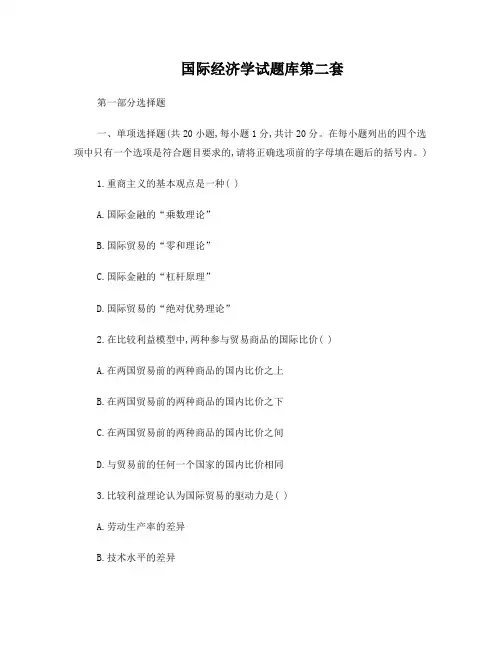
国际经济学试题库第二套第一部分选择题一、单项选择题(共20小题,每小题1分,共计20分。
在每小题列出的四个选项中只有一个选项是符合题目要求的,请将正确选项前的字母填在题后的括号内。
)1.重商主义的基本观点是一种( )A.国际金融的“乘数理论”B.国际贸易的“零和理论”C.国际金融的“杠杆原理”D.国际贸易的“绝对优势理论”2.在比较利益模型中,两种参与贸易商品的国际比价( )A.在两国贸易前的两种商品的国内比价之上B.在两国贸易前的两种商品的国内比价之下C.在两国贸易前的两种商品的国内比价之间D.与贸易前的任何一个国家的国内比价相同3.比较利益理论认为国际贸易的驱动力是( )A.劳动生产率的差异B.技术水平的差异C.产品品质的差异D.价格的差异4.一般来说,对于生产中投入的两种生产要素,当一种要素投入量不变,而另一种要素投入量持续增加时,投入量不变的那种要素的边际要素产品将()A.减少B.增加C.不变D.无法确定5.不能解释产业内贸易现象的理论有( )A.重叠需求理论B.要素比例理论C.规模经济理论D.垄断竞争理论6.能反映规模经济理论本意的是( )A.规模报酬递减B.规模报酬递增C.规模报酬不变D.规模成本递增7.不改变贸易结构,只改变贸易规模的增长方式有( )A.偏向进口的生产要素增长B.偏向出口的生产要素增长C.生产要素等比例增长D.贫困的增长8.国际贸易中发生“悲惨的增长”的条件有()A.出口产品需求价格弹性较高B.出口产品需求价格弹性较低C.出口产品需求价格无弹性D.出口产品需求价格弹性无穷大9.一种产品的竞争优势并非长期固定在某一个特定的国家,而是从技术发明国转向生产成本较低的国家,描述这一现象的理论是()A.雁形模式理论B.产品周期理论C.示范效应理论D.大宗产品理论10.下列不属于保护贸易学说的理论有( )A.幼稚工业理论B.贸易条件恶化论C.国内市场失灵论D.资源禀赋论11.最佳关税水平应等于( )A.零进口关税B.零进口关税与禁止性关税之间的水平C.禁止性关税D.禁止性关税以上12.在国际卡特尔订价中,当产品的需求弹性越小,卡特尔订价水平就( )A.越低B.越高C.不变D.不确定13.下列外汇市场中,受贸易收支影响较大的是( )A.纽约B.伦敦C.香港D.东京14.下述哪一种不属于投机性外汇交易( )A.双边套汇B.多边套汇C.套利D.套期保值15.下述哪一种属于国际收支的事后项目( )A.进出口B.利息收支C.直接投资D.特别提款权变动16.在分析国际经济学的贸易和金融问题时,我们所假设的小国所面临的供给弹性是( )A.零B.小于需求弹性C.大于需求弹性D.无穷大17.设一年前美元对人民币的汇率是1美元等于8.2345元人民币,假设美国的物价比前一年上升8%,而中国的物价水平上升10%,则美元与人民币之间理论上的汇率为( )A.8.3870B.8.085C.10.2931D.6.587618.马歇尔——勒纳条件可用来判断( )A.货币贬值程度B.国际收支状况C.货币贬值对国际收支影响程度D.汇率变动对国际收支影响程度19.最佳关税的长期目标是()A.从外国垄断厂商那里抽取部分垄断租B.保护和发展本国工业C.阻止国外商品进口D.增加本国财政收入20.APEC成立于()A.1988年B.1989年C.1990年D.1991年二、多项选择题(共5小题,每小题2分,共10分。
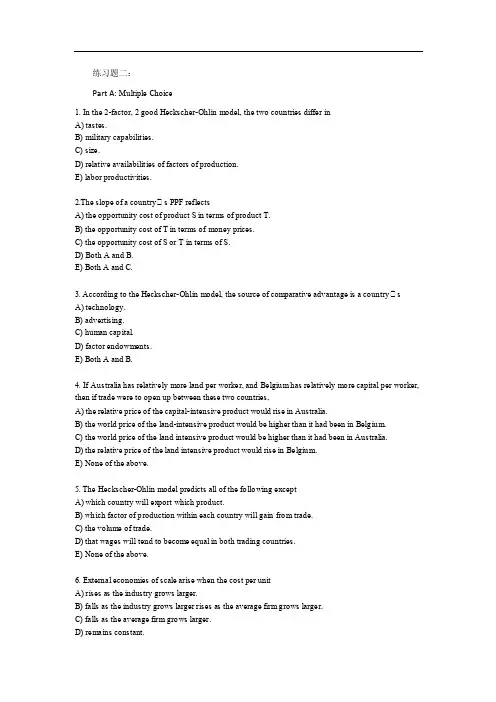
练习题二:Part A: Multiple Choice1. In the 2-factor, 2 good Heckscher-Ohlin model, the two countries differ inA) tastes.B) military capabilities.C) size.D) relative availabilities of factors of production.E) labor productivities.2.The slope of a countryʹs PPF reflectsA) the opportunity cost of product S in terms of product T.B) the opportunity cost of T in terms of money prices.C) the opportunity cost of S or T in terms of S.D) Both A and B.E) Both A and C.3. According to the Heckscher-Ohlin model, the source of comparative advantage is a countryʹsA) technology.B) advertising.C) human capital.D) factor endowments.E) Both A and B.4. If Australia has relatively more land per worker, and Belgium has relatively more capital per worker, then if trade were to open up between these two countries,A) the relative price of the capital-intensive product would rise in Australia.B) the world price of the land-intensive product would be higher than it had been in Belgium.C) the world price of the land intensive product would be higher than it had been in Australia.D) the relative price of the land intensive product would rise in Belgium.E) None of the above.5. The Heckscher-Ohlin model predicts all of the following exceptA) which country will export which product.B) which factor of production within each country will gain from trade.C) the volume of trade.D) that wages will tend to become equal in both trading countries.E) None of the above.6. External economies of scale arise when the cost per unitA) rises as the industry grows larger.B) falls as the industry grows larger rises as the average firm grows larger.C) falls as the average firm grows larger.D) remains constant.E) None of the above.7. External economies of scaleA) may be associated with a perfectly competitive industry.B) cannot be associated with a perfectly competitive industry.C) tends to result in one huge monopoly.D) tends to result in large profits for each firm.E) None of the above.8. The simultaneous export and import of widgets by the United States is an example ofA) increasing returns to scale.B) imperfect competition.C) intra-industry trade.D) inter-industry trade.E) None of the above.9. Intra-industry trade can be explained in part byA) transportation costs within and between countries.B) problems of data aggregation and categorization.C) increasing returns to scale.D) A ll of the above.E) None of the above.10. Intra-industry trade will tend to dominate trade flows when which of the following exist s?A) large differences between relative country factor availabilitiesB) small differences between relative country factor availabilitiesC) homogeneous products that cannot be differentiatedD) constant cost industriesE) None of the above.11. The larger the number of firms in a monopolistic competition situation,A) the larger are that countryʹs exports.B) the higher is the price charged.C) the fewer varieties are sold.D) the lower is the price charged.E) None of the above.12. The larger the number of firms in a monopolistic competition situation,A) the larger are that countryʹs exports.B) the higher is the price charged.C) the fewer varieties are sold.D) the lower is the price charged.E) None of the above.DADCC BACDB DDPart B:Short Questions1.ʹThe H.O. model remains useful as a way to predict the income distribution effects of trade.ʹDiscuss.Answer: T he Stolper-Samuelson theorem, one of the basic theorems arising from theHeckscher-Ohlin model yields an elegant demonstration of the fact that changes in product prices (such as will occur when trade is expanded or curtailed) telescopes its effects onto factor prices, so that not only do relative factor returns mirror product prices, but that actual returns to factors may either rise or fall in real terms. Hence, as a policy framework, the disproportionate effect trade may have on real incomes of sectors, such as skilled-labor is quite useful both theoretically and practically (or polemically)2.International trade leads to complete equalization of factor prices. Discuss.T his statement is typically ʹtrue . . . but.ʹ Under a strict and limited set of assumptions, such as the original Heckscher-Ohlin model which excludes country specific technologies; non- homothetic tastes; factor intensity reversals; large country differences in (relative) factor abundances, more factors than goods, and an equilibrium solution within the ʹcone of specializationʹ; then it may be demonstrated that internal consistency demands that the above stated sentence is ʹtrue.ʹ However, the minute one relaxes any of the above listed assumptions one may easily identify solutions, which contradict the factor price equalization theorem.3.If a scale economy is the dominant technological factor defining or establishing comparativeadvantage, then the underlying facts explaining why a particular country dominates world markets in some product may be pure chance, or historical accident. Explain, and compare this with the answer you would give for the Heckscher-Ohlin model of comparative advantage.T his statement is true, since the reason the seller is a monopolist may be that it happened to have been the first to produce this product in this country. It may have no connection to any supply or demand related factors; nor to any natural or man-made availability. This is all exactly the opposite of the Heckscher-Ohlin Neo-Classical modelʹs explanation of the determinants of comparative advantage.。
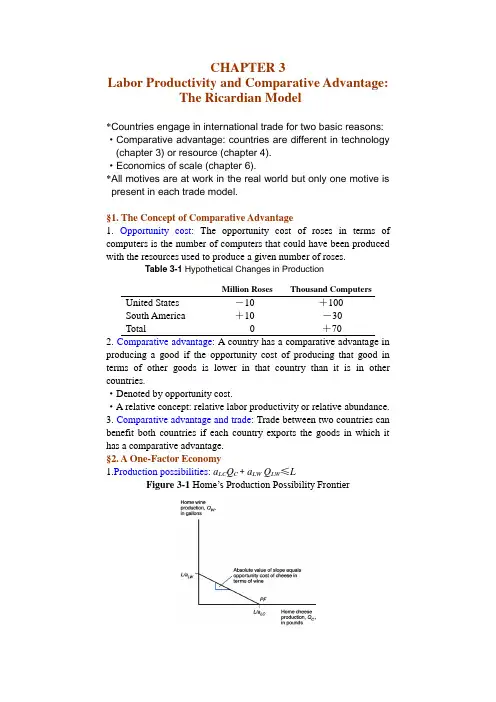
CHAPTER 3Labor Productivity and Comparative Advantage:The Ricardian Model*Countries engage in international trade for two basic reasons:·Comparative advantage: countries are different in technology (chapter 3) or resource (chapter 4).·Economics of scale (chapter 6).*All motives are at work in the real world but only one motive is present in each trade model.§1. The Concept of Comparative Advantage1. Opportunity cost: The opportunity cost of roses in terms of computers is the number of computers that could have been produced with the resources used to produce a given number of roses.Table 3-1 Hypothetical Changes in ProductionMillion Roses Thousand Computers United States -10 +100South America +10 -30Total 0 +702. Comparative advantage: A country has a comparative advantage in producing a good if the opportunity cost of producing that good in terms of other goods is lower in that country than it is in other countries.·Denoted by opportunity cost.·A relative concept: relative labor productivity or relative abundance.3. Comparative advantage and trade: Trade between two countries can benefit both countries if each country exports the goods in which it has a comparative advantage.§2. A One-Factor Economy1.Production possibilities: a LC Q C + a LW Q LW≤LFigure 3-1Home’s Production Possibility Frontier2. Relative price and supply·Labor will move to the sector which pays higher wage.·If P C/P W>a L C/a LW (P C/a L C>P W/a LW, wages in the cheese sector will be higher ), the economy will specialize in the production of cheese. ·In a closed economy, P C/P W =a L C/a LW.§3. Trade in a One-Factor World·Model: 2×1×2·Assume: a L C/a LW< a L C*/a LW*Home has a comparative advantage in cheese.Home’s relative productivity in cheese is higher.Home’s pretrade relative price of cheese is lower than foreign. ·The condition under which home has this comparative advantage involves all four unit labor requirement, not just two.(If each country has absolute advantage in one good respectively, will there exist comparative advantage?)1. Determining the relative price after trade·Relative price is more important than absolute price, when people make decisions on production and consumption.·General equilibrium analysis: RS equals RD. (World general equilibrium)·RS: a “step”with flat sections linked by a vertical section.(L/a L C)/(L*/a LW*)Figure 3-3World Relative Supply and Demand·RD: substitution effects·Relative price after trade: between the two countries’ pretrade price. (How will the size of the trading countries affect the relative price after trade? Which country’s living condition improves more? Is it possible that a country produce both goods?)2. The gains from tradeThe mutual gain can be demonstrated in two alternative ways.·To think of trade as an indirect method of production :(1/a L C)(P C/P W)>1/a LW or P C/P W>a L C/a LW·To examine how trade affects each country’s possibilities of consumption.Figure 3-4 Trade Expands Consumption Possibilities(How will the terms of trade change in the long-term? Are there income distribution effects within countries? )3. A numerical example :·Two crucial points:(1)When two countries specialize in producing the goods in which they have a comparative advantage, both countries gain from trade.(2)Comparative advantage must not be confused with absolute advantage; it is comparative, not absolute, advantage that determines who will and should produce a good.Table 3-2 Unit Labor RequirementsCheese WineHome a LC =1 hour per pound a LW =2 hours per gallon Foreign a *L C =6 hours per pound a *L W =3 hours per gallon Analysis: absolute advantage; relative price; specialization;the gains from trade.4. Relative wages·It is precisely because the relative wage is between the relative productivities that each country ends up with a cost advantage in one good.***LC LC LW LW a a w w a >> **LC LC wa w a <;**LW LW wa w a > ·Relative wages depend on relative productivity and relative demand on goods.Special box: Do wages reflect productivity?·Debates about relative wages and relative labor productivity. ·Long-run convergence in productivity produces long-run convergence in wages.§4. Misconceptions about Comparative AdvantageThe proposition that trade is beneficial is unqualified. That is, there is no requirement that a country be “competitive”or that the trade be “fair”.1. Productivity and competitivenessmyth1: Free trade is beneficial only if your country is strong enough to stand up to foreign competition.·The gains from trade depend on comparative advantage rather than absolute advantage.·The competitive advantage of an industry depend on relative labor productivity and relative wage.·Absolute advantage: neither a necessary nor a sufficient condition for comparative advantage (or for the gains from trade).2. The pauper labor argumentmyth2: Foreign competition is unfair and hurts other countries when it is based on low wages.·Whether the lower cost of foreign export goods is due to high productivity or low wages does not matter. All that matter to home is that it is more efficient to “produce” those goods indirectly than to produce directly.3. Exploitationmyth3: Trade exploits a country and makes it worse off if its workers receive much lower wage than workers in othernations.·Whether they and their country are worse off?·What is the alternative ?(If it refuses to trade, real wages would be even lower).§5. Comparative Advantage with Many Goods·Model: 2×1×n·For any good we can calculate a Li /a Li*, label the goods so that the lower the number, the lower this ratio.a L1/a L1*<a L2/a L2*<…<a LN/a LN *(or a L1*/a L1>a L2*/a L2>…>a LN*/a LN)1. Relative wages and specialization·Any good for which a Li*/a Li>w/w* will be produced in home. (Relative productivity is higher than its relative wage, wa Li<w*a Li*, goods will always be produced where it is cheapest to make them.) ·All the goods to the left of the cut end up being produced in home.Table 3-3 Home and Foreign Unit Labor RequirementsRelative HomeHome Unit Labor Foreign Unit Labor ProductivetyRequirement(a Li)Requirement(a*Li)Advantage(a*Li/a Li) Apples 1 10 10Bananas 5 40 8Caviar 3 12 4Dates 6 12 2Enchiladas 12 9 0.75If w/w*=3, A、B、C will be produced in Home and D、E in foreign. ·Is such a pattern of specialization beneficial to both countries? (Hint: Comparing the labor cost of producing import goods directly and indirectly).2. Determining the relative wage in the multigood model·w/w*: RD of labor equals RS of labor.·The relative derived demand for home labor (L/L*) will fall when the ratio of home to foreign wages (w/w*) rises, because:(1)The goods produced in home became relative more expensive.(2)Fewer foods will be produced in home and more in foreign.Figure 3-5 Determination of relative of wages.RD: derived form relative demand for home and foreign goods.RS: determined by relative size of home and foreign labor force (Labor can’t move between countries).§6. Adding Transport Costs and Nontraded Goods·There are three main reasons why specialization in the real international economy is not so extreme:(1)The existence of more than one factor of production(2)Protectionism(3)The existence of transport cost.E.g. suppose transport cost is a uniform fraction of production cost,say 100 percents. For goods C and D in table 2-4:D: Home 6hours < 12hours×1/3×2 foreignC: Home 3hours×2 >12hours×1/3 foreignThus, C and D became nontraded goods.·In practice there is a wide range of transportation costs.In some cases transportation is virtually impossible: services such as haircut and auto repair; goods with high weight-to-value ratio, like cement.·Nontraded goods: Because of absence of strong national cost advantage or because of high transportation cost.·Nations spend a large share of their income on nontraded goods.§7. Empirical Evidence on the Ricardian Model·Misleading predictions:(1)An extreme degree of specialization.(2)Neglect the effects on income distribution.(3)Neglect differences in resources among countries as a cause oftrade.(4)Neglect economics of scale as a cause of trade.·The basic prediction of the Ricardian model has been strongly confirmed by a number of studies over years.(1)Countries tend to export those goods in which their productivityis relative high.(2)Trade depends on comparative not absolute advantage.Figure 3-6Productivity and exportsAnswers to Problems of Chapter 31. a. b. a LA / a LB =3/2=1.5c. P A / P B = a LA / a LB =1.52. a.b.If the relative price of apples after trade is between 1.5 and 5, Home and Foreign will specialize in the production of apples and bananas respectively. The world relative supply of apples is:**/1200/31/800/12LA LB L a L a == 3. a. RD include the points )212()11()2,21()5,51(,、,、、b. the equilibrium relative price of apples is P A /P B =2c. Home produces only apples and trades them for bananas Foreign produces only bananas and trade them for applesd. Home :(1/ a LA )(P A /P B )=(1/3)×2= Foreign :(1/*LB a )(P A /P B )=(1/1)× =4.The equilibrium relative price of apples is 1.5, it equals pretread relative price of apples in Home, So Home produces both apples and bananas, neither gains nor loss form trade; Foreign produces only bananas and trades it for apples, Foreign gains from trade.5.The answer is identical to that in problem3 since the amount of “effective labor ”has not changed.6.·Pauper labor argument.·Relative wage reflects relative productivity, international trade can’t change it·Trading with a less productive and low-wage country will rise, nolower its standard of living.21/132=>LB a 51/121*=>LA a 217.·to determine comparative advantage need for all four unit laborrequirements (for both the manufacture and the service sectors)· is an absolute advantage in services, this is neither a necessary nor a sufficient condition for determining comparative advantage.·The competitive advantage depends on both relative productivity and relative wages.8. ·*ωω=·Since U.S. is considerably more productive in services, Service prices are relative low.·Most services are nontraded goods·P= , U.S. purchasing power is higher than that of Japan. 9.·The gains from trade decline as the share of the nontraded goodsincreases, no trade, no gains.10.·Label the countries so that(a LC /a LW )1<(a LC /a LW )2…<( a LC /a LW )N·Any country to the left of RD produces cheese and trades it for wine. Any country to right of RD produces wine and trades it for cheese.·If the intersection occurs in a horizontal portion, the Country with that a LC /a LW produces both goods.*LS LS aa <*31P。
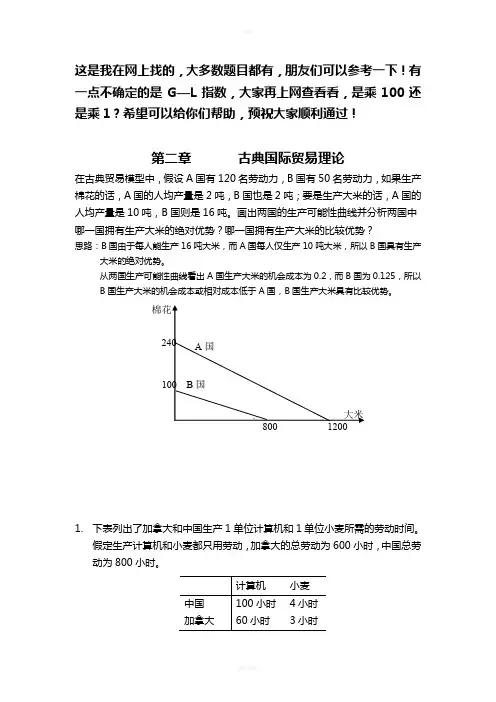
这是我在网上找的,大多数题目都有,朋友们可以参考一下!有一点不确定的是G—L指数,大家再上网查看看,是乘100还是乘1?希望可以给你们帮助,预祝大家顺利通过!第二章古典国际贸易理论在古典贸易模型中,假设A国有120名劳动力,B国有50名劳动力,如果生产棉花的话,A国的人均产量是2吨,B国也是2吨;要是生产大米的话,A国的人均产量是10吨,B国则是16吨。
画出两国的生产可能性曲线并分析两国中哪一国拥有生产大米的绝对优势?哪一国拥有生产大米的比较优势?思路:B国由于每人能生产16吨大米,而A国每人仅生产10吨大米,所以B国具有生产大米的绝对优势。
从两国生产可能性曲线看出A国生产大米的机会成本为0.2,而B国为0.125,所以B国生产大米的机会成本或相对成本低于A国,B国生产大米具有比较优势。
1.下表列出了加拿大和中国生产1单位计算机和1单位小麦所需的劳动时间。
假定生产计算机和小麦都只用劳动,加拿大的总劳动为600小时,中国总劳动为800小时。
(1)计算不发生贸易时各国生产计算机的机会成本。
(2)哪个国家具有生产计算机的比较优势?哪个国家具有生产小麦的比较优势?(3)如果给定世界价格是1单位计算机交换22单位的小麦,加拿大参与贸易可以从每单位的进口中节省多少劳动时间?中国可以从每单位进口中节省多少劳动时间?如果给定世界价格是1单位计算机交换24单位的小麦,加拿大和中国分别可以从进口每单位的货物中节省多少劳动时间?(4)在自由贸易的情况下,各国应生产什么产品,数量是多少?整个世界的福利水平是提高还是降低了?试用图分析。
(以效用水平来衡量福利水平)思路:(1)中国生产计算机的机会成本为100/4=25,加拿大为60/3=20(2)因为加拿大生产计算机的机会成本比中国低,所以加拿大具有生产者计算机的比较优势,中国就具有生产小麦的比较优势。
(3)如果各国按照比较优势生产和出口,加拿大进口小麦出口计算机,中国进口计算机出口小麦。
2、F3、T4、T5、F6、T7、T8、T9、T 10、F1、T一、名词解释:(5题,每题4分,共20分)1、 里昂惕夫之谜:里昂惕夫之谜是由美国经济学家里昂惕夫在用其所提出的投 入——产出分析方法检验美国进出口是否符合H —0理论所提出的(1分),按照 H —0理论,美国应该专业化生产并出口资本密集型的产品,进口劳动密集型的 产品(1分),但是,里昂惕夫经过检验计算得出,美国出口的是劳动密集型的 产品,进口的是资本密集型的产品,冈V 好与H —0相反(1分)。
因此,人们把这 个理论称之为里昂惕夫之谜。
围绕里昂惕夫之谜,经济学家对国际贸易理论进行 了更深入的研究C1分)2、 比较优势原理:即使一国在两种产品的生产上都较另一国没有效率,仍然可 以进行双赢的贸易C1分)。
第一国应该专业化生产并出口其绝对劣势较小的产 品,而进口其绝对劣势较大的产品(2分)。
另一个国家则进行相反的贸易(1分)。
3、 有效关税率:也叫有效关税率,是指对某个工业每单位产品"增值”部分的 从价税率,其税率代表着关税对本国同类产品的真正有效的保护程度。
4、 贸易乘数:指对外贸易对经济增长的巨大作用,(2分)通过对外贸易的发展, 从而带动国内要素的优化配置,可以对国民经济带来乘数倍的效应。
(2分)。
5、 马歇尔一勒纳条件:是勒纳在马歇尔的国际收支调节乘数论的基础上进一步 研究的结果C2分),指的是在供给弹性无穷大的情况下,如果进出口需求弹性 的绝对值大于1,货币贬值就能使一国国际收支得到改善,由逆斧变为顺斧C2 分)。
二、判断题(正确的标“T”,错误的标“F”,并将答案填入对应的方格中。
共 10题,每题1分,共10分)三、简答题(共5题,每题8分,共40分) 1、简述H —0理论的前提假设。
1、贸易中有两个国家(A 国和B 国),两种商品(X 与Y ),两种生产要素(劳动与资本)。
两国在生产中都使用相同的技术。
2、在两个国家中,商品X 都 是劳动密集型产品,商品Y 都是资本密集型产品。
国际经济学II 模拟题1 答案I.Explain why XX Curve is flatter than DD Curve in the DD-AA Model. (10 points)参考答案要点:⏹ 作图 (2分)⏹ XX 是经常帐户衡等的状态下汇率和产出的组合,而DD 是国内产出市场均衡状态下产出和汇率的组合。
(4分)⏹ 在1点处CA=X, 当Y 增加并沿着DD 移动时,本国产品国内需求增长小于Y 的增长,而Y的增加带来进口的增加。
因为有储蓄和进口两个漏损,为了保证国内产出市场的均衡,E 必须沿着DD 以更快的速度上升,使出口的增长快于进口的增长。
因此在1点的右边,XX 在DD 的下面,而在1点的右边XX 在DD 下面。
XX 比DD 平坦。
(4分)II. Discuss why the Japanese Yen keeps rising against the U.S. Dollar after the World War II with the General Model of Long-Run Exchange Rates. (20 points) 参考答案要点巴萨理论:落后国家贸易品部门生产率低于发达国家,而非贸易部门生产率与发达国家相差无几,因而落后国家总体价格水平低于发达国家;落后国家在发展过程中,贸易品部门生产率提高快并逐渐向国际接轨,贸易部门工资水平上升。
由于劳动力等生产要素的流动性,非贸易部门的工资随着提高,使非贸易品价格提高较快,导致物价总水平上涨速度快。
战后日本和美国的情况也如此(8分)。
代表一个国家价格水平的商品篮子包括贸易品和非贸易品。
战后日本经济的恢复和发展过程中,非贸易品价格的上涨导致日本一般物价水平相对美国上涨,结果是以美国商品篮子衡量的日本商品篮子价格上涨,即日圆实际汇率上升(q $/¥=E $/j × (P j / P US ))。
因此,日本非贸易品价格(以贸易品衡量)的上涨是日圆实际汇率(q $/¥)上升的主要原因。